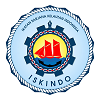PENILAIAN KERENTANAN PANTAI DI WILAYAH PESISIR KABUPATEN TUBAN TERHADAP ANCAMAN KERUSAKAN
Abstract
Analisa Kerentanan Pantai ini dilakukan di wilayah pesisir pantai utara Jawa Timur khususnya Kabupaten Tuban dengan panjang pantai 65 km. Penelitian ini bertujuan untuk mengembangkan metode pengolahan data penginderaan jauh untuk penentuan parameter terkait CVI (Coastal Vulnerability Index) terhadap ancaman kerusakan dan untuk mengetahui tingkat kerentanan pantai yang diperlukan untuk merumuskan langkah-langkah mitigasi dalam meminimalkan dampak kerusakan pantai. Langkah dari penelitian ini adalah untuk mengumpulkan hidro-oseanografi dan data geologi dan informasi dari kerusakan pesisir dari data sekunder dan survey lapangan secara langsung. Pemanfaatan data penginderaan jauh dari satelit sensor optis serta sistem informasi geografis dapat memberikan informasi spasial sebagian besar parameter-parameter yang diperlukan dalam perhitungan Indeks Kerentanan Pantai. Parameter indeks kerentanan pantai (Coastal Vulnerability Index/CVI) yang digunakan dalam pembobotan Kerentanan pantai terhadap ancaman kerusakan menggunakan 10 variabel fisik pantai, yaitu: (1). Geomorfologi pantai (GF), (2) Ketinggian Permukaan Tanah (Elevasi/E), (3) Tunggang pasut (Tidal Range) rata-rata (TR),(4) Tinggi Gelombang Signifikan (SHW) (5) Kenaikan Muka Air Laut Relatif (SLR), (6) Perubahan Garis Pantai (PGP), (7) Penggunaan Lahan (PL), (8) Litologi (L), (9) Luas Kerusakan Pantai (KP), (10) Lebar sabuk hijau (SH). Pengelompokan kelas dilakukan dengan membaginya berdasarkan persen dengan kisaran antar kelas 20%. Nilai yang kurang dari sama dengan 20% termasuk kelas tidak rentan, 20% – 40% termasuk dalam kelas kurang rentan, 40% – 60% kelas sedang, 60% – 80% masuk dalam kelas rentan, dan lebih dari 80% masuk kelas sangat rentan. Berdasarkan hasil survey, perhitungan dan analisa terhadap seluruh data, diperoleh nilai CVI wilayah pesisir pesisir utara Kabupaten Tuban yang terdiri dari 5 Kecamatan pantai dikelompokkan menjadi 4 kategori kerentanan terhadap ancaman kerusakan, yaitu: kerentanan sangat tinggi (220-275), kerentanan tinggi (165-220), kerentanan sedang (110-165), dan kurang rentan (55-110). Kecamatan Bancar termasuk dalam 4 kategori yaitu kurang rentan sampai sangant rentan, Kecamatan Jenu termasuk daerah yang rentan dan sangat rentan, Kecamatan Palang dan Tambakboyo pada kategori sedang sampai sangat rentan, sedangkan Tuban termasuk pada daerah sedang dan rentan.
Kata Kunci : kerentanan pantai, CVI, Inderaja dan SIG, ancaman kerusakan
VULNERABILITY ASSESSMENT OF TUBAN DISTRICT COASTAL AREAS TO THE DAMAGING THREAT
Coastal Vulnerability analysis was conducted in the northern coast of East Java, especially in Tuban with a coastline ca. 65 km. This research aims to develop remote sensing data processing method for the determination of parameters related to CVI (Coastal Vulnerability Index) against the damaging threat and to determine the level of vulnerability of the coast needed to formulate mitigation measures to minimize the impact of damage to the beach. Steps of this research is to collect oceanographic and hydro-geological data and information from damaged coastal from secondary data and field survey. Utilization of remote sensing data from satellites as well as the optical sensor geographic information systems can provide spatial information most of the parameters required in the calculation of Coastal Vulnerability Index. Parameter of coastal vulnerability index (CVI) that is used in weighting the beach Vulnerability to threats of physical damage using 10 variables, namely: (1). Coastal geomorphology (GF), (2) Elevation (E), (3) Stables tide (Tidal Range) Average (TR), (4) Significant Wave Height (SHW) (5) Sea Level Rise relative (SLR), (6) Changes in Coastline (PGP), (7) Land Use (PL), (8) lithology (L), (9) area of Damage Coast (KP), (10) The width of the green belt (SH). Grading is done by dividing by percent with a range between 20% grade. Values less than or equal to 20%, classes as is not vulnerable, 20% - 40% is included in the class of less susceptible, 40% - 60% of the classes of moderately vulnerable, 60% - 80% as classes vulnerable, and over 80% go to class very susceptible. Based on survey results, calculation and analysis of all data obtained CVI value of coastal areas north coast of Tuban consisting of 5 Districts beach grouped into four categories of vulnerability to the threat of damage, namely: very high susceptibility (220-275), high susceptibility (165 -220), moderate susceptibility (110-165), and less susceptible (55-110). District of Bancar included in four categories: less susceptible very vulnerable, District Jenu including vulnerable areas and are moderately vulnerable, District Palang and Tambakboyo at moderate to very vulnerable category, while Tuban included in the moderate and vulnerable areas.
Keywords: Coastal vulnerability, CVI, Remote sensing and GIS, Damaging threat.
VULNERABILITY ASSESSMENT OF TUBAN DISTRICT COASTAL AREAS TO THE DAMAGING THREAT
Coastal Vulnerability analysis was conducted in the northern coast of East Java, especially in Tuban with a coastline ca. 65 km. This research aims to develop remote sensing data processing method for the determination of parameters related to CVI (Coastal Vulnerability Index) against the damaging threat and to determine the level of vulnerability of the coast needed to formulate mitigation measures to minimize the impact of damage to the beach. Steps of this research is to collect oceanographic and hydro-geological data and information from damaged coastal from secondary data and field survey. Utilization of remote sensing data from satellites as well as the optical sensor geographic information systems can provide spatial information most of the parameters required in the calculation of Coastal Vulnerability Index. Parameter of coastal vulnerability index (CVI) that is used in weighting the beach Vulnerability to threats of physical damage using 10 variables, namely: (1). Coastal geomorphology (GF), (2) Elevation (E), (3) Stables tide (Tidal Range) Average (TR), (4) Significant Wave Height (SHW) (5) Sea Level Rise relative (SLR), (6) Changes in Coastline (PGP), (7) Land Use (PL), (8) lithology (L), (9) area of Damage Coast (KP), (10) The width of the green belt (SH). Grading is done by dividing by percent with a range between 20% grade. Values less than or equal to 20%, classes as is not vulnerable, 20% - 40% is included in the class of less susceptible, 40% - 60% of the classes of moderately vulnerable, 60% - 80% as classes vulnerable, and over 80% go to class very susceptible. Based on survey results, calculation and analysis of all data obtained CVI value of coastal areas north coast of Tuban consisting of 5 Districts beach grouped into four categories of vulnerability to the threat of damage, namely: very high susceptibility (220-275), high susceptibility (165 -220), moderate susceptibility (110-165), and less susceptible (55-110). District of Bancar included in four categories: less susceptible very vulnerable, District Jenu including vulnerable areas and are moderately vulnerable, District Palang and Tambakboyo at moderate to very vulnerable category, while Tuban included in the moderate and vulnerable areas.
Keywords: Coastal vulnerability, CVI, Remote sensing and GIS, Damaging threat.
Full Text:
PDF (Bahasa Indonesia)References
Abidin, H. Z., Andreas, H., Gumilar, I., Sidiq, T. P., Gamal, M., Murdohardono, D., Supriyadi, & Fukuda, Y. (2010). Studying Land Subsidence in Semarang (Indonesia) Using Geodetic Methods, FIG Congress 2010 Facing the Challenges Building the Capacity, Sydney, Australia 11-16 April 2010
Abuodha, P. A., & Woodroffe, C. D. (2006). Assessing Vulnerability of Coasts to Climate Change: A Review of Approaches and Their Application to the Australian Coast 2006. http:/ / ro.uow.edu.au/ (diakses 2 Maret 2013)
Aerts, J., Major, D., Cavid, C., Bowman, M. J., Dircke, P., & Marfai, M. A. (2009). Connecting Delta Cities (Coastal Cities, Flood Risk Management and Adaptation to Climate Change). VU University Press, Amsterdam
Alexandrakis, G., Karditsa, A., Poulos, S., Ghionis, G., & Kampanis, N. A. (2009). Vulnerability Assessment for to Erosion of the Coastal Zone to a Potential Sea Level Rise: The Case of the Aegean Hellenic Coast. Sydow, A. (Ed) Environmental Systems. Eolss Pub. Oxford, UK
Beatley, T., Browser, D. J., & Schwab, A. K. (2002). An introduction to coastal zone management second edition, chapter-1 pp.1-12, Island Press.
Booggs, S. (2006). Principles of Sedimentology and Stratigraphy fourth Edition. Library of Congress Cataloging-in-Publication Data. University of Oregon
Boruff, B. J., Emrich, C., & Cutter, S. L. (2005). Erosion hazard vulnerability of US coastal counties. Journal of Coastal Research, 21(5), 932-942. West Palm Beach (Floridal, ISSN 0749-0208.
Direktorat Jenderal Pesisir dan Pulau -Pulau Kecil Departemen Kelautan dan Perikanan (DKP). (2004). Pedoman Mitigasi Bencana Alam di Wilayah Pesisir dan Pulau -Pulau Kecil. Departemen Kelautan Dan Perikanan. Jakarta.
Diposaptono, S. (2008). Teknologi Adaptasi Kenaikan Paras Muka Air Laut di Wilayah Pesisir Dan Pulau-Pulau Kecil. [Slide]. Workshop Adaptasi Dan Mitigasi Kenaikan Paras Muka Air Laut Akibat Perubahan Iklim Diwilayah Pesisir Dan Pulau-Pulau Kecil. Millenium Hotel-Jakarta, 28 November 2008
Fletcher, S., & Smith, H. D. (2007). Geography and coastal management. Coastal Management, 35(4), 419-427.
Gornitz, V., Rosenzweig, C., & Hillel, D. (1997). Effects of anthropogenic intervention in the land hydrologic cycle on global sea level rise. Glob. Planet. Change, 14,147-161, doi: 10.1016/S0921-8181(96)00008-2.
Kumar, T. S., Mahendra, R. S., Nayak, S., Radhakrishnan, K., & Sahu, K. C. (2010). Coastal Vulnerability Assessment for Orissa State, East Coast of India. J Coast Res, 26(3), 523–534
Marfai, M. A., & King, L. (2008). Tidal inundation mapping under enhanced land subsidence in Semarang, Central Java Indonesia. Nat Hazards, 44, 93-109. DOI 10.1007/s11069-007-9144-z.
Nilay Kanti Barman, N. K., Chatterjee, S., & Khan, A. (2015). Trends of Shoreline Position: An Approach to Future Prediction for Balasore Shoreline. Open Journal of Marine Science, 5, 13-25
Ojeda-Zújar, J., Álvarez-Francosi, J. I., Martín-Cajaraville, D., & Fraile-Jurado, P. (2009). El uso de las TIG para el cálculo del índice de Vulnerabilidad costera (CVI) ante una potencial subida del nivel del mar en la costa andaluza (España). GeoFocus, 9, 83-100
Ozyurt, G., & Ergin, A. (2010). Improving Coastal Vulnerability Assessments to SeaLevel Rise: A New Indicator-Based Methodology for Decision Makers. J Coast Res, 26(2), 265 – 273
Pendleton, E. A., Thieler, E. R., & Williams, S. J. (2005). Coastal Vulnerability Assessment of Gateway National Recreation Area (GATE) to Sea-Level Rise. U.S. Geological Survey. Virginia, USA
Pendleton, E. A., Thieler, E. R., & Williams, S. J. (2004). Coastal Vulnerability Assessment of Gulf Islands National Seashore (GUIS)
to Sea-level Rise. Woods Hole, Mass.: U.S. Geological Survey.
Sankari, S., Chandramouli, A. R., Gokul, K., Mangala Surya, S. S., & Saranavel, J. (2015). Coastal Vulnerability Mapping Using Geospatial Technologies InCuddalore-Pichavaram Coastal Tract, Tamil Nadu, India. International Conference on Water Resources, Coastal and Ocean Engineering (Icwrcoe 2015). Aquatic Procedia, 4, 412 – 418
Shaw, J., Taylor, R. B., Forbes, D. L., Ruz, M. H., & Solomon, S. (1998). Sensitivity of the Canadian Coast to Sea-Level Rise. Geol Surv Can Bull, 505, 114
Thieler, E. R., & Hammar-Klose, E. S. (2000). National Assessmen t of Coastal Vulnerability to Sea-Level Rise: U.S. Pacific Coast. U.S. Geological Survey, Open-File Report 00-178, http://pubs.usgs.gov/of/2000/of00-178/ (diakses 3 Maret 2015)
Ward, P. J., Marfai, M. A., Yulianto, F., Hizbaron, D. R., & Aerts, J. C. J. H. (2011) Coastal inundation and damage exposure estimation: a case study for Jakarta. Natural Hazards, 56, 899-91
DOI: https://doi.org/10.21107/jk.v9i2.1667
Refbacks
- There are currently no refbacks.

This work is licensed under a Creative Commons Attribution 4.0 International License.

Jurnal Kelautan by Program Studi Ilmu Kelautan is licensed under a Creative Commons Attribution 4.0 International License.
Published by: Department of Marine Sciences, Trunojoyo University of Madura













